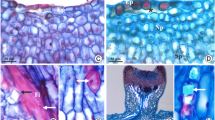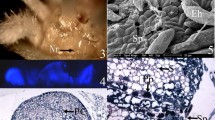Abstract
Unusual nectaries were anatomically described as being usual traits for Gentianaceae. They are small, avascularized, and formed by 3 to 5 rosette cells with labyrinthine walls around one central cell. Such as nectaries have been reported for stems, petals, and sepals of different species of the family, however, there is no information on the mechanisms involved with the synthesis and release of secretion. Thus, this work aimed to unravel the mechanism of secretion and exudation of nectar for these curious nectaries using Calolisianthus speciosus as a model. Samples were processed according to standard methods for light and electron microscopy. Leaf and sepal nectaries were described, as were those of the apex of petals where ants were observed patrolling a darkened region. The enzymatic method was used for the detection of sugars, proteins, and amino acids in leaf and sepal exudates. The nectaries of petals of C. speciosus are similar to those of its leaves, sepals, and stem, although their activities are asynchronous. Polysaccharides were detected on the labyrinthine walls of rosette cells and protein in the opposite region of the cytoplasm. Labyrinthine walls increase the contact surface between rosette cells and the central cell, allowing for the transfer of secretion. After accumulation, the secretion is released to the subcuticular space of the central cell through disruption of the cuticle. The secretion and exudation of nectar were elucidated and involve distinct organelles.







Similar content being viewed by others
Data availability
All data generated or analyzed during this study are included in this published article.
Code availability
Not applicable.
References
Avalos AA, Lattar EC, Galati BG, Ferrucci MS (2017) Nectary structure and ultrastructure in two floral morphs of Koelreuteria elegans subsp. formosana (Sapindaceae). Flora 226:29–37. https://doi.org/10.1016/j.flora.2016.11.003
Baker HG, Baker I (1977) Intraspecific constancy of floral nectar amino acid complements. Bot Gaz 138:183–191. https://doi.org/10.1086/336914
Cardoso-Gustavson P, Andreazza NL, Sawaya AC, de Moraes CM (2013) Only attract ants? The versatility of petiolar extrafloral nectaries in Passiflora. Am J Plant Sci 4:460–469. https://doi.org/10.4236/ajps.2013.42A059
Cruden RW, Herman SM, Peterson S (1983) Patterns of nectar production and plant pollination coevolution. In: Bentley B, Elias T (eds) The biology of nectaries. Columbia University Press, New York, pp 80–125
Dalvi VC, de Faria GS, Azevedo AA (2020) Calycinal secretory structures in Calolisianthus pedunculatus (Cham. & Schltdl) Gilg (Gentianaceae): anatomy, histochemistry, and functional aspects. Protoplasma 257:275–284. https://doi.org/10.1007/s00709-019-01436-5
Dalvi VC, Meira RMSA, Azevedo AA (2013) Extrafloral nectaries in neotropical Gentianaceae: occurrence, distribution patterns, and anatomical characterization. Am J Bot 100:1779–1789. https://doi.org/10.3732/ajb.1300130
Dalvi VC, Meira RMSA, Azevedo AA (2017) Are stem nectaries common in Gentianaceae Juss.? Acta Botanica Brasilica 31:403–410. https://doi.org/10.1590/0102-33062016abb0404
Dalvi VC, Meira RMSA, Francino DMT, Silva LC, Azevedo AA (2014) Anatomical characteristics as taxonomic tools for the species of Curtia and Hockinia (Saccifolieae–Gentianaceae Juss.). Plant Syst Evol 300:99–112. https://doi.org/10.1007/s00606-013-0863-1
Davis AR, Peterson RL, Shuel RW (1988) Vasculature and ultrastructure of the floral and stipular nectaries of Vicia faba (Leguminosae). Can J Bot 66:1435–1448. https://doi.org/10.1139/b88-198
Dejean A, Corbara B, Leroy C, Delabie JH, Rossi V, Céréghino R (2011) Inherited biotic protection in a Neotropical pioneer plant. PLoS ONE 6:18071. https://doi.org/10.1371/journal.pone.0018071
Del-Claro K, Rico-Gray V, Torezan-Silingardi HM, Alves-Silva E, Fagundes R, Lange D, Rodriguez-Morales D (2016) Loss and gains in ant-plant interactions mediated by extrafloral nectar: fidelity, cheats, and lies. Insectes Soc 63:207–221. https://doi.org/10.1007/s00040-016-0466-2
Delgado MN (2008) Caracterização morfoanatômica de espécies de Gentianaceae ocorrentes em áreas de cerrado e de campo rupestre em Minas Gerais. Dissertation, Universidade Federal de Viçosa
Delgado MN, Azevedo AA, Valente GE, Kasuya MCM (2011a) Comparative anatomy of Calolisianthus species (Gentianaceae-Helieae) from Brazil: taxonomic aspects. Edinb J Bot 68:139–155. https://doi.org/10.1017/S0960428610000284
Delgado MN, Silva LC, Báo SN, Morais HC, Azevedo AA (2011b) Distribution, structural and ecological aspects of the unusual leaf nectaries of Calolisianthus species (Gentianaceae). Flora 206:676–683. https://doi.org/10.1016/j.flora.2010.11.016
Do Nascimento EA, Del-Claro K (2010) Ant visitation to extrafloral nectaries decreases herbivory and increases fruit set in Chamaecrista debilis (Fabaceae) in a Neotropical savanna. Flora 205:754–756. https://doi.org/10.1016/j.flora.2009.12.040
El Ajouz B, Valentin-Silva A, Francino DMT, Dalvi VC (2022) A flower with several secretions: anatomy, secretion composition, and functional aspects of the floral secretory structures of Chelonanthus viridiflorus (Helieae—Gentianaceae). Protoplasma 259:427–437. https://doi.org/10.1007/s00709-021-01652-y
Evert RF (2013) Anatomia das plantas de Esau: meristemas, células e tecidos do corpo da planta: sua estrutura, função e desenvolvimento. Blucher, São Paulo
Fahn A (1979a) Secretory tissues in plants. Academic Press, New York
Fahn A (1979b) Ultrastructure of nectaries in relation to nectar secretion. Am J Bot 66:977–985. https://doi.org/10.2307/2442240
Feio AC, Riina R, Meira RMSA (2016) Secretory structures in leaves and flowers of two dragon’s blood Croton (Euphorbiaceae): new evidence and interpretations. Int J Plant Sci 177:511–522. https://doi.org/10.1086/685705
Fisher DB (2004) Protein staining of ribboned epon sections for light microscopy. Histochemie 16:92–96. https://doi.org/10.1007/BF00306214
Gaffal KP (2012) How common is the ability of extrafloral nectaries to produce nectar droplets, to secrete nectar during the night and to store starch? Plant Biol 14:691–695. https://doi.org/10.1111/j.1438-8677.2012.00616.x
Gilg E (1895) Ueber die Blüthenverhältnisse der Gentianaceengattungen Hockinia Gardn. und Halenia Borckh. Ber Deutschen Botanischen Gesellschaft 13:114–126
Guimarães EF, Dalvi VC, Azevedo AA (2013) Morphoanatomy of Schultesia pachyphylla (Gentianaceae): a discordant pattern in the genus. Botany 91:830–839. https://doi.org/10.1139/cjb-2013-0077
Gunning BES, Pate JS (1969) “Transfer cells” plant cells with wall ingrowths, specialized in relation to short distance transport of solutes - their occurrence, structure, and development. Protoplasma 68:107–113
Heil M, Rattke J, Boland W (2005) Post secretory hydrolysis of nectar sucrose and specialization in ant/plant mutualism. Science 308:560–563. https://doi.org/10.1126/science.1107536
Heil M (2011) Nectar: generation, regulation and ecological functions. Trends Plant Sci 16:191–200. https://doi.org/10.1016/j.tplants.2011.01.003
IEF (2022) Instituto Nacional de Florestas. http://www.ief.mg.gov.br/parque-estadual/1411. Accessed 24 May 2022
Jensen WA (1962) Botanical histochemistry: principles and practice. WH Freeman, San Francisco
Johansen DA (1940) Plant microtechnique. McGraw- Hill, New York
Lanza J, Smith GC, Sack S, Cash A (1995) Variation in nectar volume and composition of Impatiens capensis at the individual, plant, and population levels. Oecologia 102:113–119
Lillie RD (1965) Histopathologic technic and practical histochemistry. McGrawHill, New York
Mace ME, Howell CR (1974) Histochemistry and identification of condensed tannin precursor in roots of cotton seedlings. Can J Bot 52:2423–2426. https://doi.org/10.1139/b74-314
Martínez del Rio C (1990) Phylogenetic and ecological correlates of intestinal sucrase and maltase activity in birds. Physiol Zool 63:987–1011. https://doi.org/10.1086/physzool.63.5.30152625
Meira RMSA, Miranda JD, Coutinho IAC (2020) Anatomical reevaluation and novelties on the leaf marginal tooth glands in Sapium glandulosum (L.) Morong. (Euphorbiaceae): the importance of distinguishing colleters from nectaries. In: Demarco D (ed) Plant ontogeny: studies, analyses and evolutionary implications. Nova Science Publishers, New York, pp 63–83
Nepi M, Soligo C, Nocentini D, Abate M, Guarnieri M, Cai G, Pacini E (2012) Amino acids and protein profile in floral nectar: much more than a simple reward. Flora: Morphol Distrib Funct Ecol Plants 207:475–481. https://doi.org/10.1016/j.flora.2012.06.002
Nepi M (2007) Nectary structure and ultrastructure. In: Nicolson SW, Nepi M, Pacini E (eds) Nectaries and nectar. Springer, Dordrecht, pp 129–166
Nepi M (2017) New perspectives in nectar evolution and ecology: simple alimentary reward or a complex multiorganism interaction? Acta Agrobotanica 70:1704. https://doi.org/10.5586/aa.1704
Nguyen ST, McCurdy DW (2017) Wall ingrowth deposition in phloem parenchyma transfer cells in Arabidopsis: heteroblastic variations and a potential role in pathogen defense. Plant Signal Behav 12:1676–1691. https://doi.org/10.1080/15592324.2017.1338226
Nicolson SW (2007) Nectar consumers. In: Nicolson SW, Nepi M, Pacini E (eds) Nectaries and nectar. Springer, Dordrecht, pp 289–342
Nicolson SW, Thornburg RW (2007) Nectar chemistry. In: Nicolson SW, Nepi M, Pacini E (eds) Nectaries and nectar. Springer, Dordrecht, pp 215–264
Nicolson SW, Nepi M, Pacini E (2007) Nectaries and nectar. Springer, Dordrecht
O‘Brien TP, McCully ME (1981) The study of plant structure principles and select methods. Termarcarphi Pty, Ltd, Melbourne
O’Brien TP, Feder N, McCully ME (1964) Polychromatic staining of plant cell walls by toluidine blue. Protoplasma 59:367–373
Oliveira PS, Freitas AVL (2004) Ant–plant–herbivore interactions in the neotropical cerrado savanna. Naturwissenschaften 91:557–570. https://doi.org/10.1007/s00114-004-0585-x
Pacini E, Nepi M (2007) Nectar production and presentation. In: Nicolson SW, Nepi M, Pacini E (eds) Nectaries and nectar. Springer, Dordrecht, pp 167–214
Pacini E, Nepi M, Vesprini JL (2003) Nectar biodiversity: a short review. Plant Syst Evol 238:7–21. https://doi.org/10.1007/s00606-002-0277-y
Paiva ÉAS, Machado SR (2006) Ontogenesis, anatomy, and ultrastructure of Hymenaea stigonocarpa Mart. ex Hayne (Fabaceae-Caesalpinioideae) extrafloral nectaries. Acta Botanica Brasilica 20:471–482. https://doi.org/10.1590/S0102-33062006000200022
Paiva EAS (2017) How does the nectar of stomata-free nectaries cross the cuticle? Acta Botanica Brasilica 31:525–530. https://doi.org/10.1590/0102-33062016abb0444
Pearse AGE (1951) A review of modern methods in histochemistry. J Clin Pathol 4:6–36
Pearse AGE (1972) Histochemistry: theoretical and applied. The Williams and Wilkins Company, Baltimore
Pearse AGE (1980) Histochemistry. Williams and Wilkins, Baltimore
Peng YB, Li YQ, Hao YJ, Xu ZH, Bai SN (2004) Nectar production and transportation in the nectaries of the female Cucumis sativus L. flower during anthesis. Protoplasma 224:71–78. https://doi.org/10.1007/s00709-004-0051-9
Praxedes SC, DaMatta FM, Loureiro ME, Maria MA, Cordeiro AT (2006) Effects of long-term soil drought on photosynthesis and carbohydrate metabolism in mature robusta coffee (Coffea canephora Pierre var. kouillou) leaves. Environ Exp Bot 56:263–273. https://doi.org/10.1016/j.envexpbot.2005.02.008
Reynolds ES (1963) The use of lead citrate at high pH as an electron-opaque staining in electron microscopy. J Cell Biol 17:208–212. https://doi.org/10.1083/jcb.17.1.208
Rocha JF, Machado SR (2009) Anatomy, ultrastructure and secretion of Hibiscus pernambucensis Arruda (Malvaceae) extrafloral nectary. Brazilian J Bot 32:489–498. https://doi.org/10.1590/S0100-84042009000300008
Rudgers JA (2004) Enemies of herbivores can shape plant traits: selection in a facultative ant-plant mutualism. Ecology 85:192–205. https://doi.org/10.1890/02-0625
Santos VH, Minatel IO, Reco PC, Garcia A, Lima GP, Silva RM (2017) Peptide composition, oxidative and insecticidal activities of nectar from flowers of Spathodea campanulata P. Beauv Ind Crops Prod 97:211–217. https://doi.org/10.1016/j.indcrop.2016.12.025
Struwe L, Albert VA (2002) Gentianaceae: systematics and natural history. Cambridge University Press, Cambridge
Torezan-Silingard HM (2012) Flores e animais: uma introdução a história natural da polinização. In: Del-Claro K, Torezan-Silingard HM (eds) Ecologia das Interações Plantas-Animais: uma abordagem ecológico-evolutiva. Technical Books, Rio de Janeiro
Vogel S (1998) Remarkable nectaries: structure, ecology, organophyletic perspectives: II. Nectarioles Flora 193:1–29. https://doi.org/10.1016/S0367-2530(17)30798-3
Vollhardt P, Schore N (2013) Química orgânica: estrutura e função. Bookman, Porto Alegre
Wagner D, Kay A (2002) Do extrafloral nectaries distract ants from visiting flowers? An experimental test of an overlooked hypothesis. Evol Ecol Res 4:293–305
Acknowledgements
We thank Centro de Microscopia Eletrônica da Universidade Estadual de Santa Cruz (UESC) and Centro de Microscopia e Microanálise da Universidade Federal de Viçosa (UFV) for the assistance, and Dr. Rodrigo T. Ávila from Laboratório de Nutrição e Metabolismo de Plantas (UFV) for the chemical analysis. We also thank the two anonymous reviewers for the comments and suggestions that have improved our manuscript.
Funding
RMSAM received financial support from Coordenação de Aperfeiçoamento de Pessoal de Nível Superior (CAPES, Finance Code 001) and Fundação de Amparo à Pesquisa do Estado de Minas Gerais (FAPEMIG). AZA received a PhD scholarship from CAPES. RMSAM received productivity grants from CNPq — Conselho Nacional de Desenvolvimento Científco e Tecnológico (306740/2019–2).
Author information
Authors and Affiliations
Contributions
RMSAM designed the research project and advised the first author; AZA and KAB collected the samples and performed light microscopy and the histochemical analyses; VFF and AZA performed the scanning and transmission electron microscopy analyses; RMSAM, AZA, VFF, AAA and VCD wrote the paper.
Corresponding author
Ethics declarations
Conflict of interest
The authors declare no competing interests.
Additional information
Communicated by Handling Editor: Dorota Kwiatkowska.
Publisher’s note
Springer Nature remains neutral with regard to jurisdictional claims in published maps and institutional affiliations.
Rights and permissions
Springer Nature or its licensor holds exclusive rights to this article under a publishing agreement with the author(s) or other rightsholder(s); author self-archiving of the accepted manuscript version of this article is solely governed by the terms of such publishing agreement and applicable law.
About this article
Cite this article
Zanotti-Ávila, A., Fernandes, V.F., Barros, K.A. et al. Unraveling the secretion mechanism of the curious nectaries in Gentianaceae. Protoplasma 260, 637–649 (2023). https://doi.org/10.1007/s00709-022-01804-8
Received:
Accepted:
Published:
Issue Date:
DOI: https://doi.org/10.1007/s00709-022-01804-8




